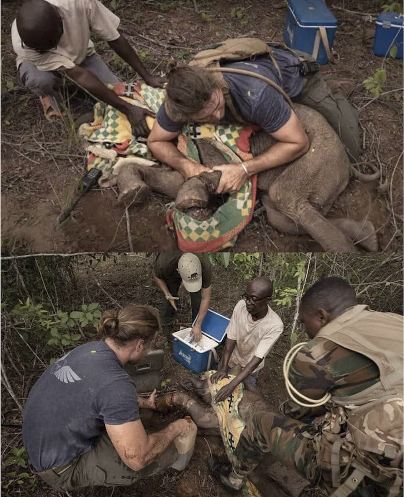
The first rays of dawn painted the savanna gold when the rangers heard a faint, pained trumpet. Following the sound, they found a young elephant calf limping through the brush, its small frame trembling. A wire snare had cut deep into her leg, slicing through skin and muscle, leaving a trail of blood in the dirt. Nearby, her mother stood guard—massive, anxious, and powerless. The calf tried to take another step but collapsed beside her. That’s when the radio crackled to life. A distress call went out to the Sheldrick Wildlife Trust and the Kenya Wildlife Service.
Within hours, the distant whir of helicopter blades filled the air. Dr. Poghon, a seasoned wildlife vet, and his team descended onto a clearing. The scene that met them was both heartbreaking and beautiful: a mother refusing to move from her injured child. The rangers knew the risk—approaching an elephant mother could be deadly—but hesitation wasn’t an option. A tranquilizer dart flew, striking her gently in the shoulder. The mother’s legs wavered, then folded as the sedation took hold. As she sank into the earth, her eyes never left her baby.
The calf trumpeted in distress, circling her fallen mother until the team approached slowly, voices calm and low. Every move had to be deliberate. A single mistake could undo everything. Kneeling in the dirt, the veterinarian examined the wound. The snare had been wrapped so tightly it had begun to grow into the flesh. He worked with surgical focus, cutting away the twisted wire while his assistants held the calf still. The smell of infection mixed with the earthy scent of rain-soaked soil. Minutes felt like hours. Finally, the last strand came free.
They flushed the wound with clean water, applied antibiotics, and packed the leg with a green clay paste to draw out infection. One ranger draped a blanket over the trembling calf, whispering softly as he patted her head. The calf’s breathing slowed. In that fragile moment between fear and calm, the forest seemed to pause—as if nature itself was holding its breath.
Then came the hardest part—reuniting them. The vet injected a reversal drug into the mother’s thick hide. Slowly, she stirred. Her ears twitched first, then her trunk. When she finally rose, the team stepped back. For a second, the mother froze, uncertain. Then she spotted her baby and let out a deep, resonant rumble that vibrated through the ground. The calf answered, limping toward her. Their trunks intertwined in a silent embrace, a reunion that spoke of love older than time.
The rescue team watched in awe. They had seen hundreds of operations, yet each reunion left its own mark. The two elephants lingered a moment longer, the mother shielding her calf from the wind, before turning back toward the forest. Together, they disappeared into the acacia shadows—two silhouettes against the rising sun.
Later, the team named the calf Hope. It was fitting. Hope was not just for the baby who had survived, but for all who fight to protect what cannot defend itself. In the wilderness of Kenya, every life saved is a promise—a reminder that compassion can outshine cruelty.
In the quiet aftermath, the helicopter blades spun up again. As they lifted off, Dr. Poghon looked down at the patch of forest where the elephants had vanished. The earth bore no trace of the wire snare—only footprints leading home. He smiled faintly, knowing that tomorrow might bring another call, another desperate cry. But today, Hope had been given back to the wild.